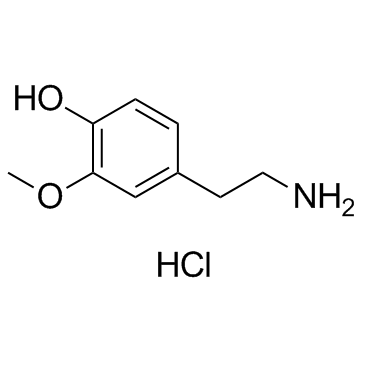3-Methoxytyramine hydrochloride

3-Methoxytyramine hydrochloride structure
|
Common Name | 3-Methoxytyramine hydrochloride | ||
|---|---|---|---|---|
| CAS Number | 1477-68-5 | Molecular Weight | 203.666 | |
| Density | N/A | Boiling Point | 306.8ºC at 760 mmHg | |
| Molecular Formula | C9H14ClNO2 | Melting Point | 213 - 215ºC | |
| MSDS | Chinese USA | Flash Point | 139.3ºC | |
| Symbol |

GHS07 |
Signal Word | Warning | |
|
Orally administrated dipeptide Ser-Tyr efficiently stimulates noradrenergic turnover in the mouse brain.
Biosci. Biotechnol. Biochem. 79 , 1542-7, (2015) In this study, we examined the effect of orally administrated dipeptides containing Tyr (Y) on the metabolism of catecholamines in mouse brains. We found that among eight synthetic dipeptides whose sequences are present frequently in soy proteins, Ser-Tyr (SY... |
|
|
Facile synthesis of Fe₃O₄@polyethyleneimine modified with 4-formylphenylboronic acid for the highly selective extraction of major catecholamines from human urine.
J. Sep. Sci. 38 , 2857-64, (2015) The levels of catecholamines, especially dopamine, epinephrine and norepinephrine in urine and plasma have been used to assist the diagnosis and treatment of psychosis. Due to their low endogenous concentrations, the determination of the three major catechola... |
|
|
Simultaneous analysis of multiple neurotransmitters by hydrophilic interaction liquid chromatography coupled to tandem mass spectrometry
J. Chromatogr. A. 1395 , 79-87, (2015) • A novel HILIC-MS/MS method for neurotransmitters, precursors and metabolites analysis. • Different HILIC stationary phases were evaluated. • Zwitterionic stationary phases were the most suitable for neurotransmitter analysis. • Application of neuronal metab... |
|
|
Microchip electrophoresis with electrochemical detection for the determination of analytes in the dopamine metabolic pathway.
Electrophoresis 36 , 1912-9, (2015) A method for the separation and detection of analytes in the dopamine metabolic pathway was developed using microchip electrophoresis with electrochemical detection. The microchip consisted of a 5 cm PDMS separation channel in a simple-t configuration. Analyt... |
|
|
Salsolinol, an endogenous compound triggers a two-phase opposing action in the central nervous system.
Neurotox. Res. 27(3) , 300-13, (2015) Salsolinol (1-methyl-6,7-dihydroxy-1,2,3,4-tetrahydroisoquinoline), an endogenous compound present in the brain, was suspected of participation in the etiopathogenesis of Parkinson's disease, the most common serious movement disorder worldwide. In this study,... |
|
|
Laboratory evaluation of pheochromocytoma and paraganglioma.
Clin. Chem. 60(12) , 1486-99, (2014) Pheochromocytomas and paragangliomas (PPGLs) are potentially lethal yet usually surgically curable causes of endocrine hypertension; therefore, once clinical suspicion is aroused it is imperative that clinicians choose the most appropriate laboratory tests to... |
|
|
[Significance of 3-methoxytyramine urine measurement in the diagnosis of pheochromocytomas and paragangliomas: about 28 patients].
Ann. Biol. Clin. (Paris.) 69(5) , 555-9, (2011) Measurement of catecholamines derivatives is used to diagnose tumors such as pheochromocytomas and paragangliomas. Despite the low incidence of these diseases, their diagnosis is essential because of potentially lethal episodes of malignant hypertension relat... |
|
|
Ionic cross talk can lead to overestimation of 3-methoxytyramine during quantification of metanephrines by mass spectrometry.
Clin. Chem. 58(7) , 1156-8, (2012)
|
|
|
Fibroblast growth factor receptor signaling affects development and function of dopamine neurons - inhibition results in a schizophrenia-like syndrome in transgenic mice.
J. Neurochem. 97(5) , 1243-58, (2006) Developing and mature midbrain dopamine (DA) neurons express fibroblast growth factor (FGF) receptor-1 (FGFR1). To determine the role of FGFR1 signaling in the development of DA neurons, we generated transgenic mice expressing a dominant negative mutant [FGFR... |
|
|
Pilot quality assurance programme for plasma metanephrines.
Ann. Clin. Biochem. 47(Pt 2) , 137-42, (2010) Up to 2007 there was no formal external quality assurance programme for plasma free metanephrines. A pilot programme was conceived by the AACB (Australian Association of Clinical Biochemists) Working Party on biogenic amines. With support from the AACB and Ro... |